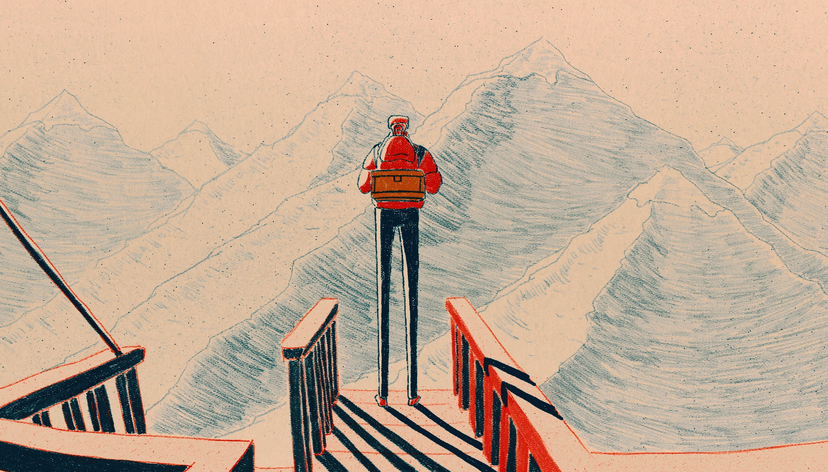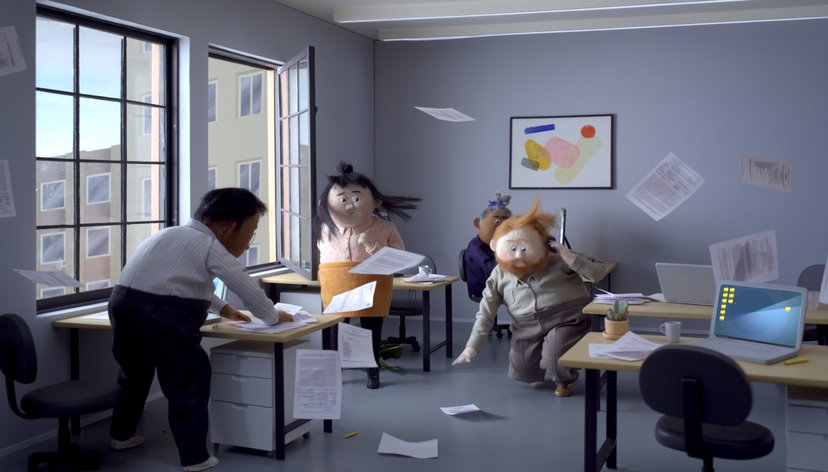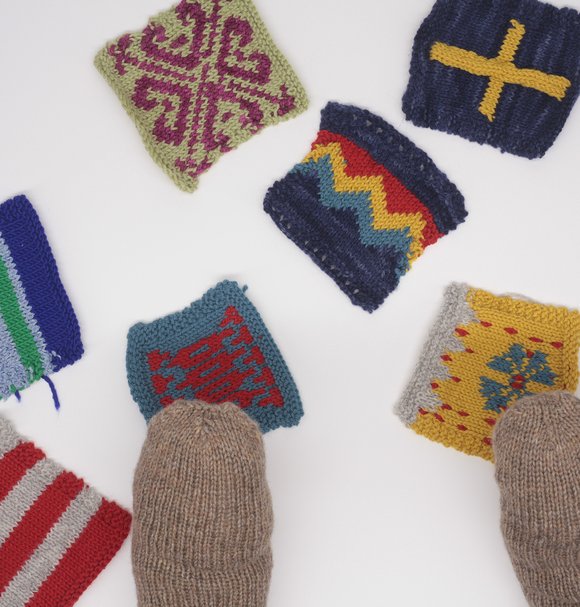
Key details
Date
- 14 February 2024
Read time
- 6 minutes
BAFTA nominated filmmaker and RCA Head of Animation Dr Samantha Moore reveals the ideas and process behind her latest film, what fascinates her about animation and why studying at the RCA is unique.
Key details
Date
- 14 February 2024
Read time
- 6 minutes
Dr Samantha Moore is a UK based, international award-winning animation director and researcher. She has made work on diverse subjects, from competitive sweet pea growing to cutting edge microbiology, archaeology, neuroscience, and her own experience of having twins.
Her recent short documentary Visible Mending, has been nominated for a BAFTA and a British Animation Award. We spoke about the process behind the film, her passion for animation and what it is like studying Animation MA the RCA.

What is Visible Mending about and what motivated you to make it?
Visible Mending’s tagline is ‘emotional repair through wool’ and I think this sums up the film’s intentions – presenting people’s stories about how they have used knitting, crocheting and textile arts to manage challenging emotional situations.
The idea originated from my own history; my mum got early onset dementia in her 60s and forgot how to follow a knitting pattern (although she could still physically knit for a while). As she declined, I taught myself to knit via YouTube videos, and I realised how much solace knitting brought me. It struck me that knitting would be a great subject for an animated film because there is so much shared ground – the incremental making of a project, but pursued at a snail’s pace!
Visible Mending has the voices of seven contributors, who tell us about the ways in which knitting and crocheting have helped them and why. The stories are funny, sad and poignant, and each contributor is represented by a different knitted object.

“Knitting has a rhythm and an energy that is meditative but powerful and I think people haven’t seen that represented on screen before.”
Head of Programme Animation
Visible Mending has been hugely successful – why do you think the film resonates with such a broad audience?
I have had so many emails and messages from people who want to share their own stories, that it seems the connection is in the recognition of themselves in our film. Knitting has a rhythm and an energy that is meditative but powerful and I think people haven’t seen that represented on screen before. Animation is also a medium that bears rewatching – you often see little details that you missed the first time – and many people have reported rewatching Visible Mending several times, which makes me so happy.
Your background is in 2D animation – why was stop motion the right format for this story? How did that decision come about?
It was clear from the beginning that this should be a stop motion project, but the idea of that initially threw me. I am a 2D animator (and love that way of working), but it was obvious that the film needed to be really tactile and haptic in the way it functioned. The audience needed to imagine they could feel the knitted objects, in the way that Bagpuss or the Clangers evoke that space between reality and dream state.
The film was five years in the making, you spent a long time researching and making connections with knitting communities and the people represented in the film. What makes these kinds of collaborations successful?
I think that taking so long to make those connections and develop those relationships means that the collaborators (I prefer that word to interviewee or ‘subject’ as it seems so reductive) get to really impact the finished look of the film as well as the sound. Each collaborator chose their own knitted object to represent themselves, and some of them actually knitted their own objects. This meant that it was a real challenge to animate objects like the sweater (Lyn), or the hat (Carmel), but that was part of the creative challenge for me.
“Animation is a Trojan horse, within which you can smuggle all kinds of information, and an audience will rarely find it threatening or challenging… until it is too late!”
Head of Programme Animation
What does animation offer as a means of storytelling or documentary practice – that other forms don’t?
Animation is often underestimated as a ‘grown up’ form, but I think that this is one of its strengths. Animation is a Trojan horse, within which you can smuggle all kinds of information, and an audience will rarely find it threatening or challenging… until it is too late! Animation can evoke the internal really well too, and since we all experience our perceptions of the external world and our internal landscape simultaneously, there is something incredibly personal about the way it works with an audience.

What is your background and what was your pathway into animation?
My first degree was in English Literature and Fine Art at Exeter University, and I became obsessed with animation after seeing the work of both Caroline Leaf and Jan Švankmajer at an animation festival. I then went to Central Saint Martins and studied Fine Art Film, where I spent all my time doing oil on glass animation and making my first documentary. I subsequently did a PhD at Loughborough university with Professor Paul Wells, who was an invaluable guide and mentor.
“Animation can make the most complex science understandable by its ability to condense information.”
Head of Programme Animation
Your PhD was about how animation can document neuropsychological brain states – you have often worked with people from scientific or medical backgrounds. What interests you in this area? What can animation, or the arts generally, offer to these fields?
I have a longstanding interest in science, I think I am just insatiably curious about everything and everyone. Animation can make the most complex science understandable by its ability to condense information. Think about science diagrams in textbooks, they are more likely to be black and white line drawings than full colour photos, because the data is more easily assimilated as lines.
I have recently worked with Professor Serge Mostowy at the London School of Hygiene and Tropical Medicine, and it was fascinating to discuss this incredibly complex science and then find ways of helping an audience connect with it through animation.

What makes the Animation MA programme at the RCA unique?
Animation at the RCA gives students the opportunity to immerse themselves in all areas of the form, and to think about the way that they position themselves as practitioner-researchers. Animation is such a powerful tool – what do they want to say with it? How can they engage with ideas, and then communicate those to an audience?
How does your teaching inform your research and making? (and vice versa?)
My research and teaching are irrevocably intertwined. I love teaching but I also need to make my own work, so that I can express my own ideas and hold my own position. I feel incredibly privileged to be able to have the amazing, stimulating, challenging conversations with students and colleagues (academic, technical, and professional services) that I do for a living, and I hope to never take that privilege for granted.
“They should know that diversity (of all kinds) is our huge strength and part of what makes the RCA special.”
Head of Programme Animation
Students are welcomed to the Animation programme from diverse backgrounds – what should a student who has not studied animation before expect from the programme?
We welcome students from all kinds of backgrounds, and we recognise that they have to have a hunger to be conversant in some of the basic craft skills to get the most from this programme. But that conversation will look different for everyone. They should know that diversity (of all kinds) is our huge strength and part of what makes the RCA special. I love the William Blake quote ‘comparison is the thief of joy’ and I would encourage all artists and filmmakers to hold onto their joy!

You worked with a team of animators with expertise in stop-motion on Visible Mending. Is this collaborative way of working common within animation? How does the Animation MA programme set students up for this way of working?
All art / film making is both a collaboration and a solitary experience. We encourage students to develop their ideas and perspectives, but then they will need to communicate those firstly to themselves (how can I articulate my ideas?) and then to others; tutors, peers and collaborators, before presenting their work to an audience. Communication is key and we have plenty of critiques, presentations, pitching and discussion sessions, so that their work is rigorously interrogated and explored. Even their exams are by viva, which is a discussion.
“We know our alumni have become some of the most influential and lauded animators of their generations”
Head of Programme Animation
What do graduates from the Animation MA programme go on to do?
This is a good question, and one of my colleagues Dr Carla Mackinnon is doing some post doctoral research on this now, as we approach our 40th year of the MA Animation at RCA in 2025. Students become part of a huge network of animators and artists when they come to the RCA; which spans countries, continents, forms, and concepts. We know our alumni have become some of the most influential and lauded animators of their generations but our ambition for them remains embarrassingly earnest – that they make good work and improve the world.


